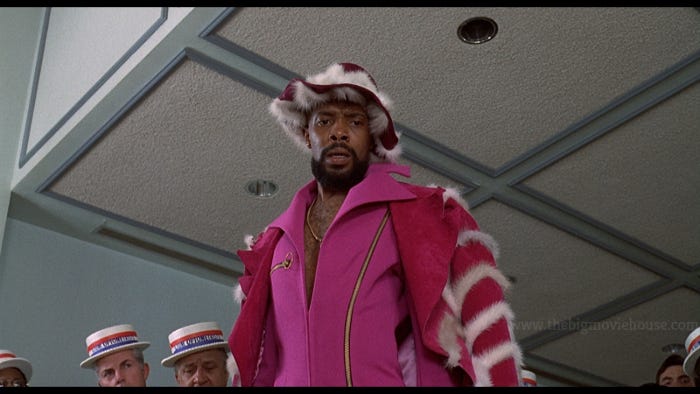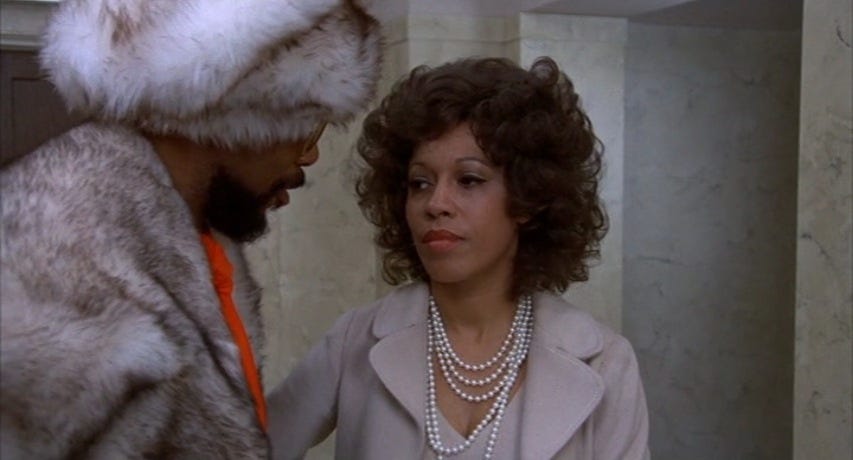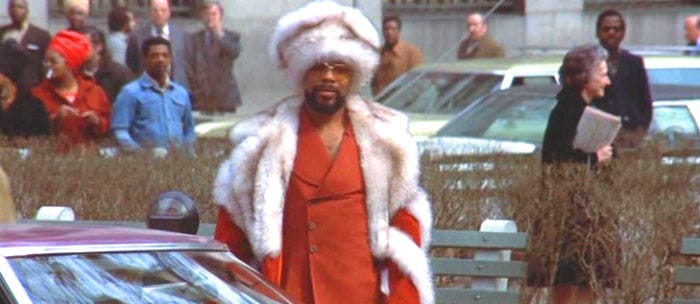Blaxploitation Education: Willie Dynamite
If you want to know why pimpin' ain't easy, have I got a movie for you.
Willie Dynamite
Written by Ron Cutler
Directed by Gilbert Moses
1973
When you watch enough Blaxploitation movies, you find yourself caught in a sort of push and pull between finding criminal activity interesting and exciting and realizing that maybe depicting this type of activity in a positive or even celebratory manner might not be the best idea. Of course, that could be said about all crime movies, and people rarely wring their hands about whether films starring white people are morally deficient because they depict bank robberies, heists, cons, or other criminal schemes. It’s not fair that Black people seem to have to answer for their entire race, but whoever said that American society was fair to Black people?
While the attitudes taken toward crime in Blaxploitation movies varied pretty widely, the popularity of the genre did lead to some pushback from people and organizations that weren’t too happy about what they saw as negative portrayals of the Black community. This led to some movies that tried to operate as a corrective, including some that strove to provide positive depictions of the Black community (Five on the Black Hand Side) and others that took harsh anti-drug stances (Gordon’s War). This wasn’t always successful, sometimes resulting in movies like Super Fly T.N.T., which tried so hard to make up for the sins of its predecessor that it came off as desperate while also being incredibly boring. But by approaching these ideas thoughtfully, some filmmakers were able to deepen the genre, exploring the allure of crime while providing characters with the opportunity to improve and reform.
That’s what we get with Willie Dynamite, which depicts the pimp lifestyle as exciting and luxurious while also showing how harmful it ultimately is to everyone involved. Unlike The Mack, which seemed to celebrate the way pimps subjugate women, it lets its female characters have agency, providing some understanding of why they may choose this lifestyle but also having characters try to give them a way out. It also offers a chance for redemption for someone who has wronged others, making it seem like anyone can turn their life around and do better for themselves, others, and their community. While this might sound didactic and tiresome, it’s anything but, which is due to some excellent performances by people on multiple sides of the conflicts that we see.
The title character is the primary pimp in this movie, and he’s played by Roscoe Orman, who is better known for spending several decades playing Gordon on Sesame Street. Seeing a beloved children’s performer playing a hardened criminal might seem like it would cause cognitive dissonance, but Orman throws himself into the performance, making Willie charismatic and exciting, with a drive to stand out as the best of the best in New York’s pimp community. Early on, he gives one of his women a pep talk, telling her “Willie’s sellin’ an idea! You makin’ these chumps believe they gettin’ the thrill of their lives!” He wears outfits that are ridiculously over the top, including coats and hats that aren’t just fur-lined, they invent new lines to place fur on. Plus, he drives a purple pimpmobile that makes a statement, although as his fortunes fall later on, the way it keeps getting towed becomes kind of a running joke.
On the opposite side of the law is Cora, a social worker who is the girlfriend of Robert, the Assistant District Attorney (Thalmus Rasulala, who we’ve previously seen in Cool Breeze and Blacula). In their intro scene, Robert says that he wants her to marry him, but she declines, saying that as the wife of the D.A., she’ll be considered one of “the fuzz,” which will prevent her from being able to connect with the people she is trying to reach who have been caught up in the criminal justice system. She’s played by Diana Sands, who sadly died of pancreatic cancer shortly after this movie was released. Based on this performance, that was a real loss, since she’s excellent as someone who is empathetic and driven to help others while also being strong enough to refuse to be intimidated by men who believe that they can dominate women.
Cora gets involved in the plot when Pashen (Joyce Walker), the youngest of the women working for Willie, gets arrested. Cora offers her a way out of this lifestyle, saying she can help her get work as a model. It seems like Pashen is about to accept her help when Willie swoops in with his lawyer to post bail for her. While she is happy to go with him, he slaps her for causing him trouble and costing him money, which angers Cora enough that she decides to make bringing him down her mission.
Interestingly, Cora’s first step isn’t to sic her boyfriend on Willie or try to get the police to investigate him. Instead, she goes to visit Willie’s stable of women and talks to them about how he’s mistreating them. When they show off the fancy clothes, shoes, and bags that he has bought for them, she points out that she could find the same items for much less than he claimed that they were worth, while arguing that they’re the ones who are doing all the work while he’s making all the profits. She makes a feminist case for women being able to handle their own business rather than being controlled by a man. Later, in a confrontation with Willie, she describes herself as a “Ralph Nader for hookers,” and she tells him that she’s going to make him “Number one minus one, which equals zero.”
So that’s the conflict for most of the movie, with Cora using every effort she can to take down Willie and Willie struggling to deal with threats on multiple fronts, including increased pressure from law enforcement and continued encroachment on his territory from rival pimps. Even though he’s the title character, he’s something of a villain, although he’s charismatic enough to keep viewers interested in his travails. Even if we don’t necessarily want him to succeed in his criminal efforts, he ends up being a well-developed character who experiences a downfall that’s somewhat upsetting to watch.
The most fascinating aspect of the movie is its belief that Willie can be redeemed. When it seems like he’s on the verge of either being arrested or killed, Robert is surprised that Cora isn’t happy about this. In fact, she seems kind of surprised about this herself, perhaps because she recognized some humanity in Willie underneath all of his bluster, or maybe because she makes a brief connection with Willie’s mother before the older woman collapses after learning of his crimes.
While the movie’s climax sees Willie fighting desperately against the forces arrayed against him (including an extended chase-and-shootout scene in which he is wearing a pink shirt underneath a bell-bottomed pantsuit), we see him not only struggling to survive but also experiencing some recriminations for how his actions have affected others. Given the chance for revenge against one of the other pimps who wronged him, he can’t bring himself to murder the guy. In the end, it seems like he’s decided to change his ways, and while this could seem like a cheap attempt at redemption, Orman really sells his anguish and his decision to be a better man.
This movie really worked for me, serving as an emotional exploration of the character types that we often see in these movies, giving them memorable arcs and making us believe that redemption is possible. In a movie that’s about pimps who live lives of excess based on how they control women, it takes the time to provide a feminine perspective, showing both the allure of what seems like a glamorous lifestyle and the deadening effect of their complete loss of control and autonomy.
Director Gilbert Morris handles this story well, bringing the exaggerated world to life in a way that makes it exciting while refusing to flinch away from the darkness it’s built on. With his humanistic approach, it makes sense that a few years later, he would be one of the directors who worked on the landmark TV miniseries Roots. He also wrote the songs on the soundtrack, which were sung by Martha Reeves, including a theme song that’s probably a little too tied to the movie to be a hit on its own but is still kind of a banger. It’s a pretty great showing all around, and it’s unfortunate that he didn’t do more Blaxploitation movies. But at least we got one good one out of him, as well as a couple of indelible performances from Orman and Sands. While Willie Dynamite goes in some directions that the Blaxploitation genre didn’t always follow, it serves as an example of the depths that were available for these movies to explore.
Blaxploitation Education index:
UpTight
Cotton Comes to Harlem
Watermelon Man
The Big Doll House
Shaft
Sweet Sweetback’s Baadasssss Song
Super Fly
Buck and the Preacher
Blacula
Cool Breeze
Melinda
Slaughter
Hammer
Trouble Man
Hit Man
Black Gunn
Bone
Top of the Heap
Across 110th Street
The Legend of N***** Charley
Don’t Play Us Cheap
Shaft’s Big Score!
Non-Blaxploitation: Sounder and Lady Sings the Blues
Trick Baby
The Harder They Come
Black Mama, White Mama
Black Caesar
The Mack
Book of Numbers
Charley One-Eye
Ganja & Hess
Savage!
Coffy
Shaft in Africa
Super Fly T.N.T.
Scream Blacula Scream
Cleopatra Jones
Terminal Island
Gordon’s War
Slaughter’s Big Rip-Off!
Detroit 9000
Hit!
The Spook Who Sat by the Door
The Slams
Five on the Black Hand Side
The Black 6
Hell Up in Harlem
I Escaped From Devil’s Island
Blackenstein
The Bad Bunch
That Man Bolt








Yes- that Martha Reeves theme song is infectious ("Seven women in the palm of his hand/Willie D...").
And yes- learning of this film's star, my jaw dropped. ("Is this what Gordon used to make a living doing?").